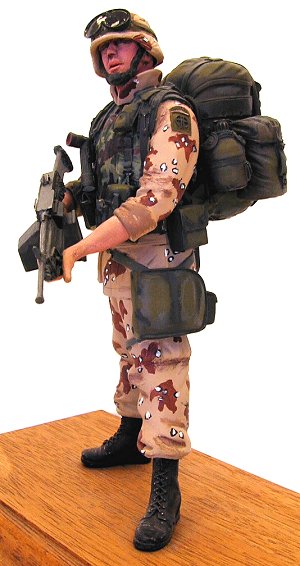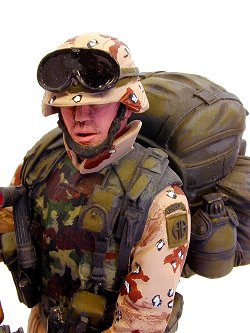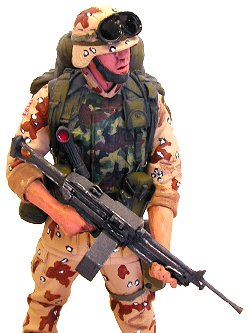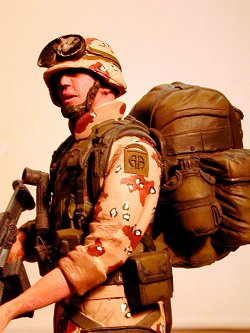
|
KIT # |
628 |
|
PRICE: |
$36.25 |
|
DECALS: |
|
|
REVIEWER: |
Blair Stewart |
|
NOTES: |
Resin |
|
HISTORY |

The 82nd did not make another combat jump after World War II until December 1989 as part of Operation Just Cause in Panama. In 1990, the division was part of the first American troops deployed to Saudi Arabia after the Iraqi invasion of Kuwait. When the ground phase of Operation Desert Storm began in February 1991, the vehicle-mounted 82nd, as part of the XVIII Airborne Corps, drove deep into Iraq and captured numerous Iraqi soldiers and equipment.
The Army introduced the M-249 squad automatic weapon (SAW) to troops in 1984. The weapon is a lightweight, 5.56mm machine gun that provides additional firepower for rifle squads. The weapon uses a 30 or 200 round magazine and gives the individual SAW gunner the ability to hit targets at longer ranges and for longer times than the M16s of a squad’s riflemen.
|
THE KIT |
 The Verlinden series of 120mm
resin figures is an excellent, extensive collection of military figures. As a
predominant aircraft modeler, I like to delve into the realm of “something
completely different” from time to time to restore my enthusiasm for my usual
modeling pursuits. To this end, these figures provide a great aside when
advanced stages of the dreaded “modeler’s syndrome” set in.
The Verlinden series of 120mm
resin figures is an excellent, extensive collection of military figures. As a
predominant aircraft modeler, I like to delve into the realm of “something
completely different” from time to time to restore my enthusiasm for my usual
modeling pursuits. To this end, these figures provide a great aside when
advanced stages of the dreaded “modeler’s syndrome” set in.
Like most of these figures, the Verlinden Desert Storm SAW gunner comes in several parts attached to resin casting blocks. The head, arms, torso and legs are separate components, as are the soldier’s individual pieces of equipment. The sculpting of the figure is extremely sharp with the great detail afforded by the large 120mm scale.
The model includes all of the major equipment carried by U.S. soldiers during Desert Storm: rucksack, extra ammunition pouches, flashlight, M9 multipurpose bayonet, canteen, entrenching tool, etc. In addition, the figure includes theextra ammo magazines carried by SAW gunners.
The kit also contains the goggles that were worn during the operation to protect against both the glare of the sun and blowing sand. The casting of the SAW itself is also excellent and provides a realistic representation of this important infantry weapon when assembled and painted.
|
CONSTRUCTION |
 Besides painting, the
biggest challenge with these figures is removing the individual components from
the resin casting blocks. Depending on the size of the part, I find it best to
use a razor saw to remove the largest part of the block, then whittle down the
remaining material using an Xacto knife. Once this is done, the figure can be
assembled. The best product to use is cyanoacrylate (CA) or “super” glue to
secure the parts.
Besides painting, the
biggest challenge with these figures is removing the individual components from
the resin casting blocks. Depending on the size of the part, I find it best to
use a razor saw to remove the largest part of the block, then whittle down the
remaining material using an Xacto knife. Once this is done, the figure can be
assembled. The best product to use is cyanoacrylate (CA) or “super” glue to
secure the parts.
After gluing the torso, legs, and arms together, I used 3M Acryl-Blue Glazing Putty to fill the seam between the parts. I then spray painted the assembled body and set it aside.
I glued the helmet on the figure’s head, and then painted this assembly by hand. Individual pieces of equipment were then painted and attached to the figure using CA glue.
|
PAINT |
The desert camouflage scheme was a challenge for me, but a good set of paintbrushes and a little patience will go a long way. Model Master’s paints were used overall, and the box art’s photograph of a completed model served as a guide during the painting process. MM Dark Tan lightened with white was used for the overall uniform color, then Olive Drab, Dark Brown, and White were used for the desert camo pattern.
The body armor, on the other hand, was painted in the jungle camo pattern seen on so many Desert Storm troopers (I’m guessing there wasn’t enough time to produce sufficient numbers of these with a desert camo pattern to support the buildup for Desert Storm, so the Defense Department went with the jungle camo. Any of you former Desert Storm participants might enlighten us on the discussion board if you have the real scoop on this). Additional equipment was painted with lightened OD. I painted the division patch on the left shoulder OD with black lettering and freehanded a small American flag patch on the figure’s right shoulder.
 I chose
MM Gloss Black for the goggles to represent bright sunlight lenses (I think
these goggles have interchangeable lenses to accommodate various visual
situations and conditions, but I could be wrong. Again, I would love to hear the
“true skinny” from any Desert Stormers out there about this particular item of
soldier equipment). The face and exposed arms were painted using artist’s oils.
This is the most difficult facet of painting figures, and I must admit I am not
too good at it.
I chose
MM Gloss Black for the goggles to represent bright sunlight lenses (I think
these goggles have interchangeable lenses to accommodate various visual
situations and conditions, but I could be wrong. Again, I would love to hear the
“true skinny” from any Desert Stormers out there about this particular item of
soldier equipment). The face and exposed arms were painted using artist’s oils.
This is the most difficult facet of painting figures, and I must admit I am not
too good at it.
Eyes seem to be the most difficult part of the facial anatomy to reproduce, as making them look realistic is a real challenge. The saving grace on this figure is that the helmet brim, coupled with the sculpted “squint” of the soldier, tend to hide this problem much more so than on other figure kits. Once assembled and painted, I used a variety of darker shade paints to highlight creases and other features on the model.
The SAW was painted using MM Gunmetal, then lightly dry brushed with MM aluminum to highlight it.
As a final touch, I mounted the figure on a pine base that I purchased at a craft’s store. I stained the base with wood stain and then covered it with a light coat of marine varnish.
|
CONCLUSIONS |
 As I stated earlier, this
model provided excellent therapy for a real bad case of the syndrome. After
completing the kit, I even broke down and bought several more figures in
Verlinden’s series (including their WWII Luftwaffe and U.S. Navy fighter pilots)
to put aside for another time when I will need a therapeutic fix.
As I stated earlier, this
model provided excellent therapy for a real bad case of the syndrome. After
completing the kit, I even broke down and bought several more figures in
Verlinden’s series (including their WWII Luftwaffe and U.S. Navy fighter pilots)
to put aside for another time when I will need a therapeutic fix.
Given the fact that so many “grunts” are now involved in the war on terrorism, I felt it was important to honor these outstanding individuals with a figure model of one of their own. Too often us “flyboy” types tend to forget that the real brunt of battle is most often borne by “boots on the ground”. My hat is off to all of you who have served or are now serving in the ground components of our Armed Forces.
|
REFERENCES |
1. “About the 82nd,”http://www.bragg.army.mil/www-82DV/about_82nd.htm, 2002.
2. “M-249 Squad Automatic Weapon (SAW),” http://www.au.af.mil/au/awc/systems/dvic536.htm, 2002.
Blair Stewart
Copyright ModelingMadness.com
If you would like your product reviewed fairly and quickly, please contact the editor or see other details in the Note to Contributors.
Back to Reviews Page 2019